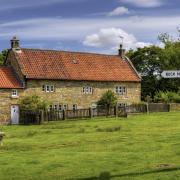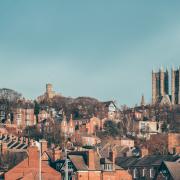Modern and traditional combine to great effect in one West Yorkshire village, as Chris Titley finds out Photographs by Joan Russell
Many visitors to Boston Spa will wander along the High Street and have a vague feeling that the village dates back a couple of hundred years or so. After all it owes both its name and its fame to the natural springs discovered in the mid-1700s.
‘It was known by writers as a place to take the water, go for walks and enjoy the scenery, because it’s got the river running through it and the gorges,’ says Malcolm Barnes. ‘It grew up as a Georgian village with a high street with lots of houses and hotels in the nice Georgian style built with local limestone. So that’s what people think of as the history of Boston Spa.’
In truth it goes a lot further back. Twelve years ago Malcolm started the Boston Spa Archaeology and Heritage Group and this dedicated band have made some remarkable finds. ‘To me the most interesting thing is the prehistoric site that we discovered and worked on for many years, culminating in the excavation of two pit alignments stretching across a field with all sorts of things deposited in them. This had become a kind of ceremonial site, right through the Neolithic period to the bronze and iron ages.’
It turns out man has been busy going about his Boston Spa business for several thousand years. That’s mainly thanks to the River Wharfe that runs through it, once a key route from east to west. The prehistoric tools uncovered by the archaeology group were all made of flint carried here by the river from the east coast.
Right next to the weir are the remains of a property known as Dam House. Thought to be the ferryman’s home in days gone by, the house has gone except for the basement.
Malcolm’s group is working hard to conserve this unique piece of industrial history, and have removed six tonnes of silt so far.
Members have shared their discoveries via an online heritage trail. This guided walk leads you from the prehistoric fields and limestone cliffs in the west along the river to Dam House and beyond, pointing out interesting features along the way.
‘When you go to places and walk around you don’t really know what you’re looking at,’ Malcolm said. ‘The idea of the heritage trail is so people can see a field, a building or a woodland and realise what’s happened there before and appreciate it. Boston Spa is special in all sorts of ways. The more you investigate the more you realise it is a special place.’
That’s something that Rachel Bentley agrees with. ‘a very vibrant place to visit,’ she says. ‘It sits to one side of Wetherby, which has a lot of visitors, and Boston Spa isn’t discovered by people. But people love it when they come, they think it’s a special place to visit.’
Today the village mixes old and new very successfully. This is epitomised by the relaunch of Boston Spa’s WI group. There is little more traditional than the Women’s Institute. But when three mums, Karen Slade, Louisa Garton, Zara Batty, decided to found a village branch they took a fresh approach. Among the subjects they plan to cover at future meetings are contemporary topics like do-it- yourself and dressing to impress.
‘The image of the WI has changed and a lot of younger people are interested in what the WI does and what it stands for,’ says Rachel, a committee member.
‘We wanted to set up a modern WI that was accessible to people of all ages, whether they had been members before or not.’
Since the inaugural meeting in October more than 70 women have joined. In February they are holding a speed dating-style event where members get a few minutes to introduce themselves to one another. ‘It’s modern yet traditional. On the launch night we had a cheese and wine tasting with a local wine expert, which was a little bit different.’
But as Rachel points out, even die-hard WI traditions like jam making and crafts are ‘becoming part of everyday life: look at the organic movement, or Kirstie Allsopp’s TV programmes – Kirstie’s a member of the WI now.’
People from all backgrounds have joined up, she says. ‘We would like to try to get people to do other things.
We want to encourage people to set up special interest groups, maybe organise theatre trips, try different crafts, or just meet up for coffee to get to know each other.’
Paper palace
Another building in Boston mixing the old and the new is the British Library.
Since it opened in a former ordnance factory in 1961, the Yorkshire outpost of the famous library has amassed more than seven million items in its role as a document supply centre. Work is now underway on a �10 million extension, to be used as a newspaper warehouse.
The British Library’s unrivalled newspaper collection, which dates from the 16th century, contains both UK and overseas titles. It was at risk, with 15 per cent of the collection unusable because of its deterioration. The solution was to place all of the physical newspapers into a new, state of the art newspaper storage building at Boston Spa. The building will have 100 miles of high density shelf space, fully automated and operating under special environmental conditions.
Following on from this move, the library will continue to digitise the best of its historical collections, enabling it to open up the collections and make them widely accessible online
Getting there: Boston Spa is just south of Wetherby and is easy to get to from both the A1 and A659
Where to park: There’s a car park off the High Street
What to do: Go on the heritage trail – find it at the Boston Spa Archaeology and Heritage Group website bsparch.org.uk
The print version of this article appeared in the January 2012 issue of Yorkshire Life
We can deliver a copy direct to your door – order online here


























